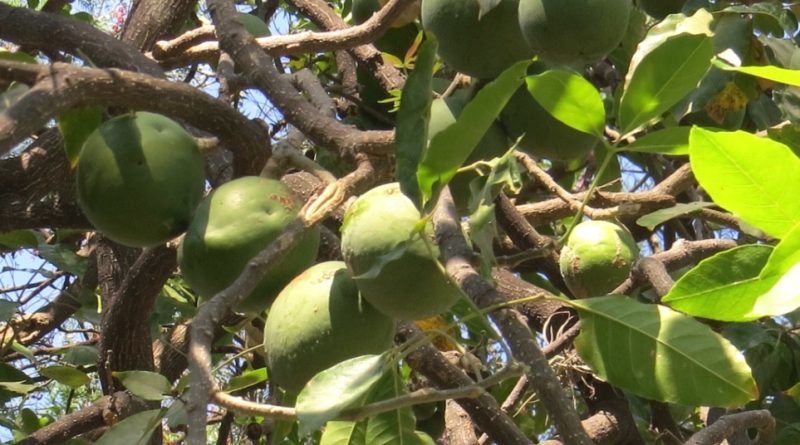Casimiroa edulis
Casimiroa edulis
The White Sapote (Casimiroa edulis La Llave) is a tropical and semi-tropical tree species of the Rutaceae family.
Systematics –
From the systematic point of view it belongs to the Eukaryota Domain, Plantae Kingdom, Magnoliophyta Division, Magnoliopsida Class, Subclass Rosidae, Sapindales Order, Rutaceae Family and quaindi to the Genus Casimiroa and to the C. edulis Species.
Etymology –
The term Casimiroa was dedicated to the Spanish botanist Casimiro Gómez de Ortega (1740-1818), professor at the Royal Botanical Garden of Madrid, predecessor of José Cavanilles. The specific epithet edulis derives from the Latin edulis, -e, that is edible, edible, referring to its fruits.
Geographical Distribution and Habitat –
White Sapote is a tropical and subtropical evergreen species originating from Mexico (where it is called white Zapote) and from Nicaragua. This plant is cultivated in countries with a subtropical climate due to its edible fruit, whose taste varies according to the cultivar.
Description –
Casimiroa edulis is an evergreen tree 8 to 15 m tall, very branched. It has aromatic, compound leaves, with five copper-red and then green leaflets, narrow 2-3 cm, and 10 to 18 cm long.
In spring, bunches of fragrant green or white flowers bloom.
The fruits, which are drupes, are rounded in shape, can reach 10 – 12 cm in diameter and have a greenish-yellow, thin and tender skin. The white pulp has a creamy consistency due to its low fiber content. The fruits ripen at the end of the summer. Each fruit has from 1 to 5 seeds similar to those of Lemon, but much larger and harder as almonds, they are also bitter, narcotic and is not edible.
There are mainly two varieties, the one with green fruits and the one with yellow fruits, with white or yellowish pulp respectively.
Cultivation –
Casimiroa edulis is a plant cultivated for its edible fruits with a peach flavor, with a thin yellowish skin and a sweet and fragrant cream colored pulp; it is very popular in the tropics but is well suited to regions with mild winters, such as Sicily. It withstands up to -6 ° C, especially in arid soil. Abrupt frosts can induce leaf fall, without serious problems.
This plant prefers fresh and clayey soils – sands, well drained, requiring some summer watering. Reproduction can take place by seed, by cuttings and by grafting.
Some varieties have been selected that have a reduced pollinating capacity, while others have a great abundance, ignoring this fact some growers have reported a difficult fruiting for isolated specimens.
Normally the plant is cut from young to a height of one meter in order to induce an already branched form from the base, and enlarged, to limit its height development.
It is a fast-growing plant with weak wood.
Uses and Traditions –
This plant, in the territories of origin is called Zapote blanco, (Sapote Bianco) but the term “sapote” (from Nahuatl “tzapotl”) is only generic, in the sense that it describes, with different adjectives, many different fruits that have the characteristic of be sweet and juicy. The white pulp is rich in vitamin A and vitamin C and is particularly sweet, because it contains more than 26% of sugars. The fruits, which ripen at the end of the summer, are harvested when they still have a firm consistency and in 5-6 days they reach perfect ripeness. The bark, leaves and seeds contain an alkaloid, the casimiroina, which has the property of lowering blood pressure.
The seeds are used for medicinal purposes; in fact these induce drowsiness, so much so that they are also known as “sleep sapote”.
The seeds owe their toxicity to the alkaloid content, which may be pharmacologically active as anti-cancer drugs; their activity is being studied for colon cancer. The effect budgets have not yet been defined.
The plant was known as early as the Aztecs but is still very little known today; probably other parts of the plant (leaves, bark) also contain alkaloids.
This species is used in folk medicine in cases of insomnia and rheumatic pains. In high doses it can be deadly. The wood is compact and of medium strength, although not very resistant, sometimes used in carpentry.
Preparation Mode –
The white Sapote has inside a pulp with a decidedly exotic flavor, approachable to peach or mango-papaya. It can be enjoyed by cutting the fruit vertically, removing the outer skin and dicing the pulp and then eating it with a fork. The fruits can also be eaten fresh or as jam.
Guido Bissanti
Sources
– Acta Plantarum – Flora of Italian Regions – Wikipedia, the free encyclopedia – Treben M., 2000. Health from the Pharmacy of the Lord, Advice and experiences with medicinal herbs, Ennsthaler Publisher – Pignatti S., 1982. Flora d ‘Italy, Edagricole, Bologna. – Conti F., Abbate G., Alessandrini A., Blasi C. (edited by), 2005. An annotated checklist of the Italian vascular flora, Palombi Editore.
Attention: Pharmaceutical applications and food uses are indicated for informational purposes only, do not in any way represent a medical prescription; therefore no liability is accepted for their use for curative, aesthetic or food purposes.



Casimiroa was named for Casimiro Gomez, x-1815, an indigenous Mexican (Otomi) officer in the war of independence, a native of Cardonal, Hidalgo.
Here is the original dedication from Novorum Vegetabilium Descriptiones, La Llave & Lexarza, 1825: “Casimiro Gómez, ad Cardonal ex tribu Ottomitarum edito, viro sobrio ac temperanti, in gerendo bello, promto, sagaci animosissimo, ipsl, quod á luxu abhorrens, el se et milites suos humili victu ac vestila conservans ac ducens, exigua Ottomitarum manu, innumerabilia ac gloriosissima pro patriae bono gesserit,—D. Ll.”